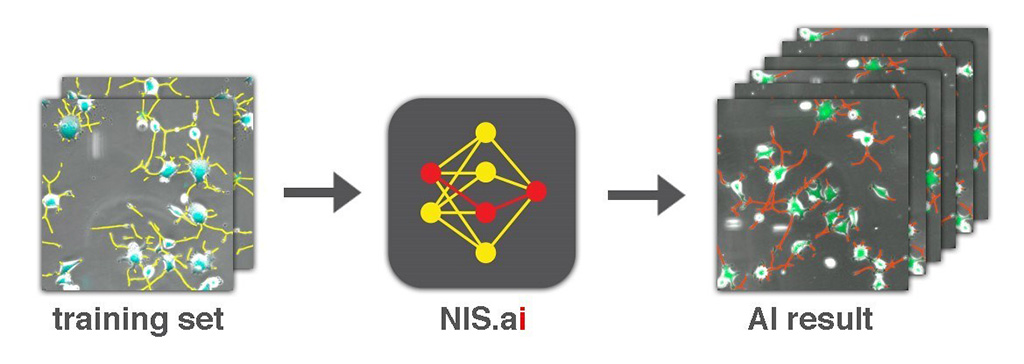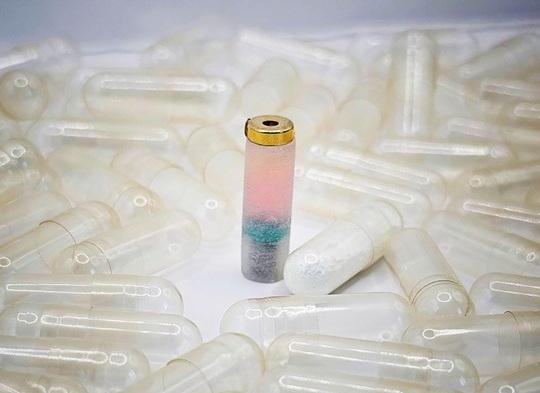AI Module Delivers Predictive Image Segmentation and Processing
|
By HospiMedica International staff writers Posted on 23 Dec 2019 |

Image: A suite of microscopy applications aid predictive imaging, segmentation, and processing (Photo courtesy of Nikon Instruments)
A powerful image analysis and processing module leverages deep learning and artificial intelligence (AI) to accurately extract unbiased data from vast amounts of microscopy datasets.
The Nikon Instruments (Melville, NY, USA) NIS.ai microscopy image analysis and processing module is a suite of AI-based processing tools that utilizes convolutional neural networks (CNNs) in order to learn how to read images from small training datasets supplied by the user. The training results can then be applied to process and analyze huge volumes of data, allowing researchers to increase throughput and expand their application limits. The NIS.ai includes a suite of applications for predictive imaging, image segmentation, and processing. These include:
Convert.ai, which learns related patterns in two different imaging channels. After training, Convert.ai can predict the pattern in the second channel, even when presented with only the first channel. It can also be trained to predict where DAPI-based fluorescent staining of nuclei--a common method for cell segmentation and counting--could be based on unstained differential interference contrast (DIC) or phase-contrast microscopy images. This enables users to perform nuclei-based image analysis without ever having to stain samples with DAPI or acquire a fluorescent channel.
Segment.ai, which enables complex structures to be easily identified and segmented. Neurites in phase-contrast images are traditionally difficult to define by classic thresholding. Segment.ai can be trained on a small subset of hand-traced neurites to automatically detect and segment neurites from thousands of untraced datasets.
Enhance.ai, which allows dim fluorescent samples with poor signal-to-noise ratio (SNR) to be enhanced by learning what a high signal-to-noise image looks like, via a process that compares under-exposed and optimally-exposed images. Enhance.ai can then restore details in under-exposed or dim fluorescent images, enabling researchers to gain more insights from their low-signal imaging applications.
Denoise.ai, which removes shot noise from resonant confocal images and can be performed in real-time. Applying Denoise.ai to resonant confocal imaging enables users to acquire confocal images at ultra-high speed without sacrificing image quality.
“The application of Deep Learning and AI to biomedical imaging is extremely powerful, and opening up unseen possibilities,” said Steve Ross, PhD, director of products and marketing at Nikon Instruments. “With NIS.ai, researchers can easily apply deep learning to extract meaningful, unbiased data from large, complex datasets.”
Related Links:
Nikon Instruments
The Nikon Instruments (Melville, NY, USA) NIS.ai microscopy image analysis and processing module is a suite of AI-based processing tools that utilizes convolutional neural networks (CNNs) in order to learn how to read images from small training datasets supplied by the user. The training results can then be applied to process and analyze huge volumes of data, allowing researchers to increase throughput and expand their application limits. The NIS.ai includes a suite of applications for predictive imaging, image segmentation, and processing. These include:
Convert.ai, which learns related patterns in two different imaging channels. After training, Convert.ai can predict the pattern in the second channel, even when presented with only the first channel. It can also be trained to predict where DAPI-based fluorescent staining of nuclei--a common method for cell segmentation and counting--could be based on unstained differential interference contrast (DIC) or phase-contrast microscopy images. This enables users to perform nuclei-based image analysis without ever having to stain samples with DAPI or acquire a fluorescent channel.
Segment.ai, which enables complex structures to be easily identified and segmented. Neurites in phase-contrast images are traditionally difficult to define by classic thresholding. Segment.ai can be trained on a small subset of hand-traced neurites to automatically detect and segment neurites from thousands of untraced datasets.
Enhance.ai, which allows dim fluorescent samples with poor signal-to-noise ratio (SNR) to be enhanced by learning what a high signal-to-noise image looks like, via a process that compares under-exposed and optimally-exposed images. Enhance.ai can then restore details in under-exposed or dim fluorescent images, enabling researchers to gain more insights from their low-signal imaging applications.
Denoise.ai, which removes shot noise from resonant confocal images and can be performed in real-time. Applying Denoise.ai to resonant confocal imaging enables users to acquire confocal images at ultra-high speed without sacrificing image quality.
“The application of Deep Learning and AI to biomedical imaging is extremely powerful, and opening up unseen possibilities,” said Steve Ross, PhD, director of products and marketing at Nikon Instruments. “With NIS.ai, researchers can easily apply deep learning to extract meaningful, unbiased data from large, complex datasets.”
Related Links:
Nikon Instruments
Latest AI News
Channels
Critical Care
view channel
AI Heart Attack Risk Assessment Tool Outperforms Existing Methods
For decades, doctors have relied on standardized scoring systems to assess patients with the most common type of heart attack—non-ST-elevation acute coronary syndrome (NSTE-ACS). The GRACE score, used... Read more
'Universal' Kidney to Match Any Blood Type
Blood-type incompatibility has long been one of the greatest obstacles in organ transplantation, forcing thousands of patients—particularly those with type O blood—to wait years longer for compatible donors.... Read moreSurgical Techniques
view channel
Minimally Invasive Endoscopic Surgery Improves Severe Stroke Outcomes
Intracerebral hemorrhage, a type of stroke caused by bleeding deep within the brain, remains one of the most challenging neurological emergencies to treat. Accounting for about 15% of all strokes, it carries... Read more
Novel Glue Prevents Complications After Breast Cancer Surgery
Seroma and prolonged lymphorrhea are among the most common complications following axillary lymphadenectomy in breast cancer patients. These postoperative issues can delay recovery and postpone the start... Read morePatient Care
view channel
Revolutionary Automatic IV-Line Flushing Device to Enhance Infusion Care
More than 80% of in-hospital patients receive intravenous (IV) therapy. Every dose of IV medicine delivered in a small volume (<250 mL) infusion bag should be followed by subsequent flushing to ensure... Read more
VR Training Tool Combats Contamination of Portable Medical Equipment
Healthcare-associated infections (HAIs) impact one in every 31 patients, cause nearly 100,000 deaths each year, and cost USD 28.4 billion in direct medical expenses. Notably, up to 75% of these infections... Read more
Portable Biosensor Platform to Reduce Hospital-Acquired Infections
Approximately 4 million patients in the European Union acquire healthcare-associated infections (HAIs) or nosocomial infections each year, with around 37,000 deaths directly resulting from these infections,... Read moreFirst-Of-Its-Kind Portable Germicidal Light Technology Disinfects High-Touch Clinical Surfaces in Seconds
Reducing healthcare-acquired infections (HAIs) remains a pressing issue within global healthcare systems. In the United States alone, 1.7 million patients contract HAIs annually, leading to approximately... Read moreHealth IT
view channel
Printable Molecule-Selective Nanoparticles Enable Mass Production of Wearable Biosensors
The future of medicine is likely to focus on the personalization of healthcare—understanding exactly what an individual requires and delivering the appropriate combination of nutrients, metabolites, and... Read moreBusiness
view channel
Philips and Masimo Partner to Advance Patient Monitoring Measurement Technologies
Royal Philips (Amsterdam, Netherlands) and Masimo (Irvine, California, USA) have renewed their multi-year strategic collaboration, combining Philips’ expertise in patient monitoring with Masimo’s noninvasive... Read more
B. Braun Acquires Digital Microsurgery Company True Digital Surgery
The high-end microsurgery market in neurosurgery, spine, and ENT is undergoing a significant transformation. Traditional analog microscopes are giving way to digital exoscopes, which provide improved visualization,... Read more
CMEF 2025 to Promote Holistic and High-Quality Development of Medical and Health Industry
The 92nd China International Medical Equipment Fair (CMEF 2025) Autumn Exhibition is scheduled to be held from September 26 to 29 at the China Import and Export Fair Complex (Canton Fair Complex) in Guangzhou.... Read more









.jpg)






